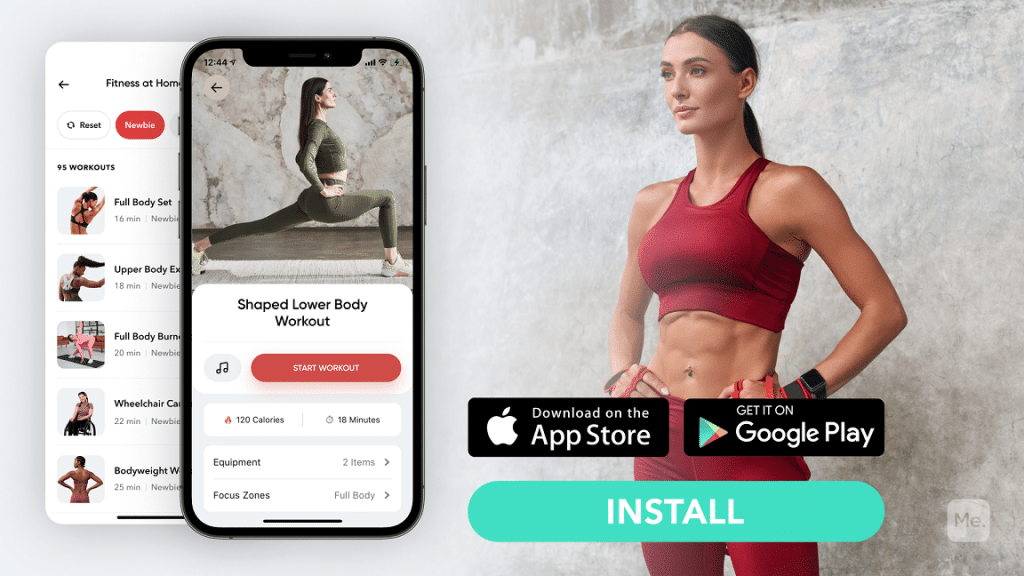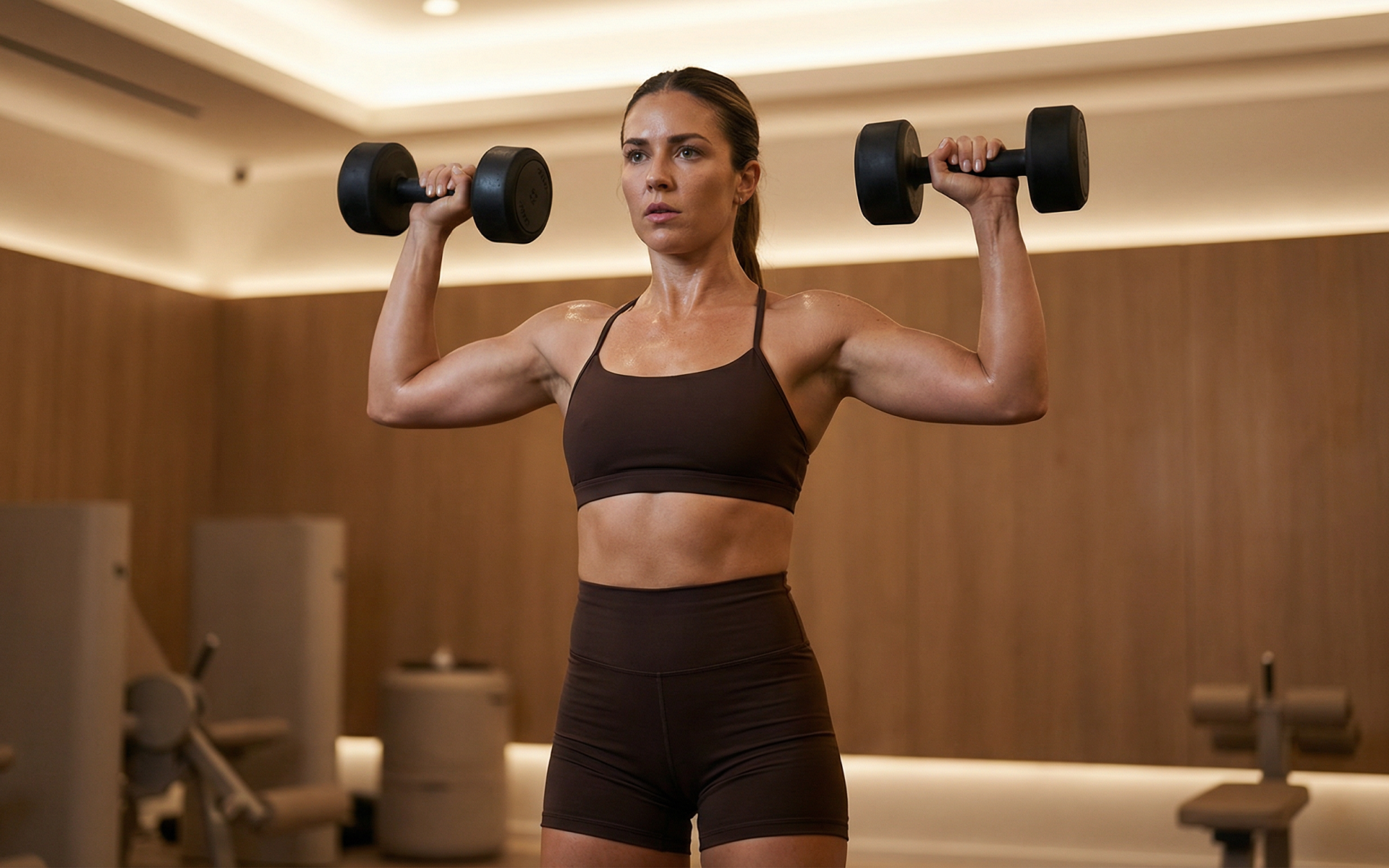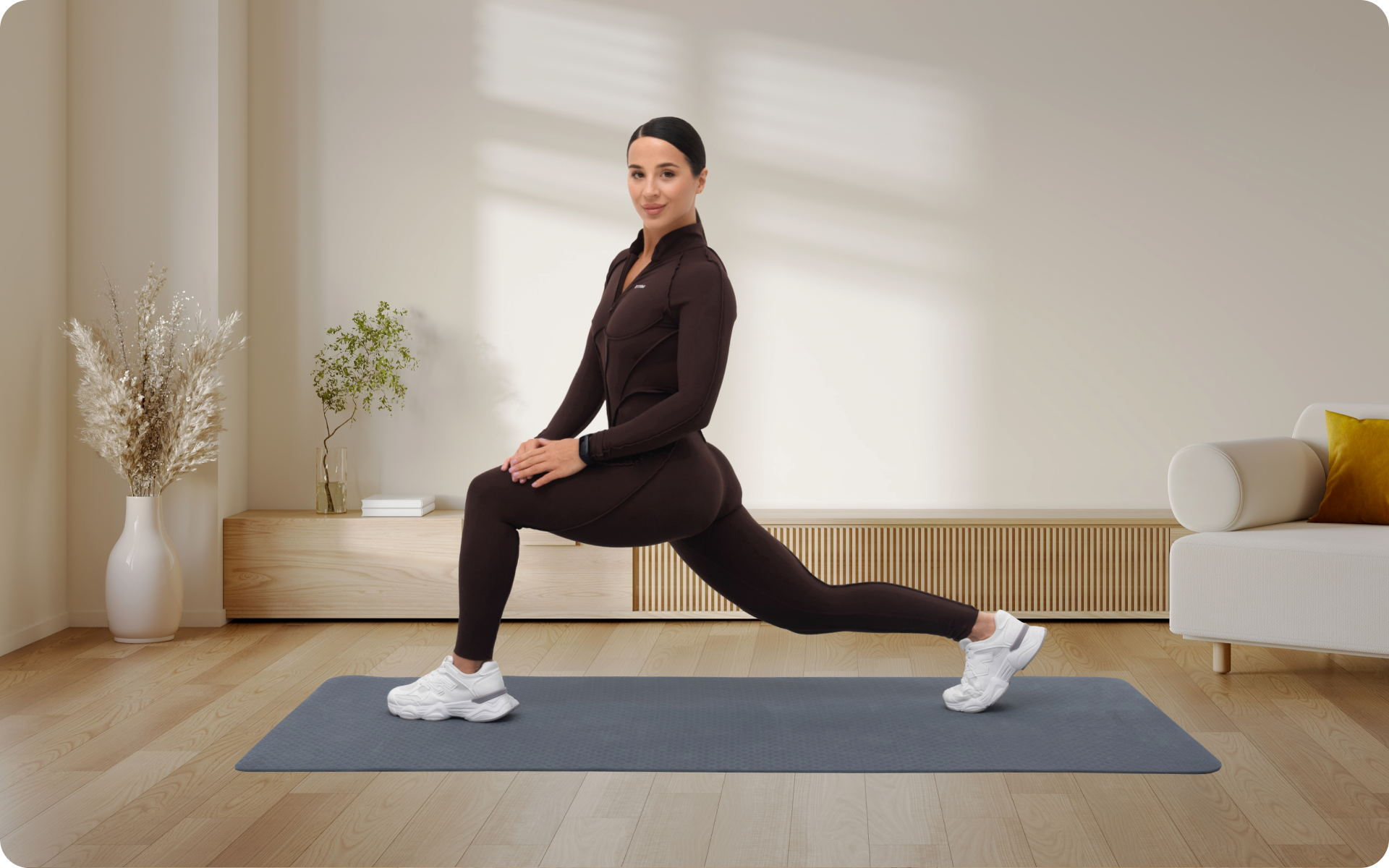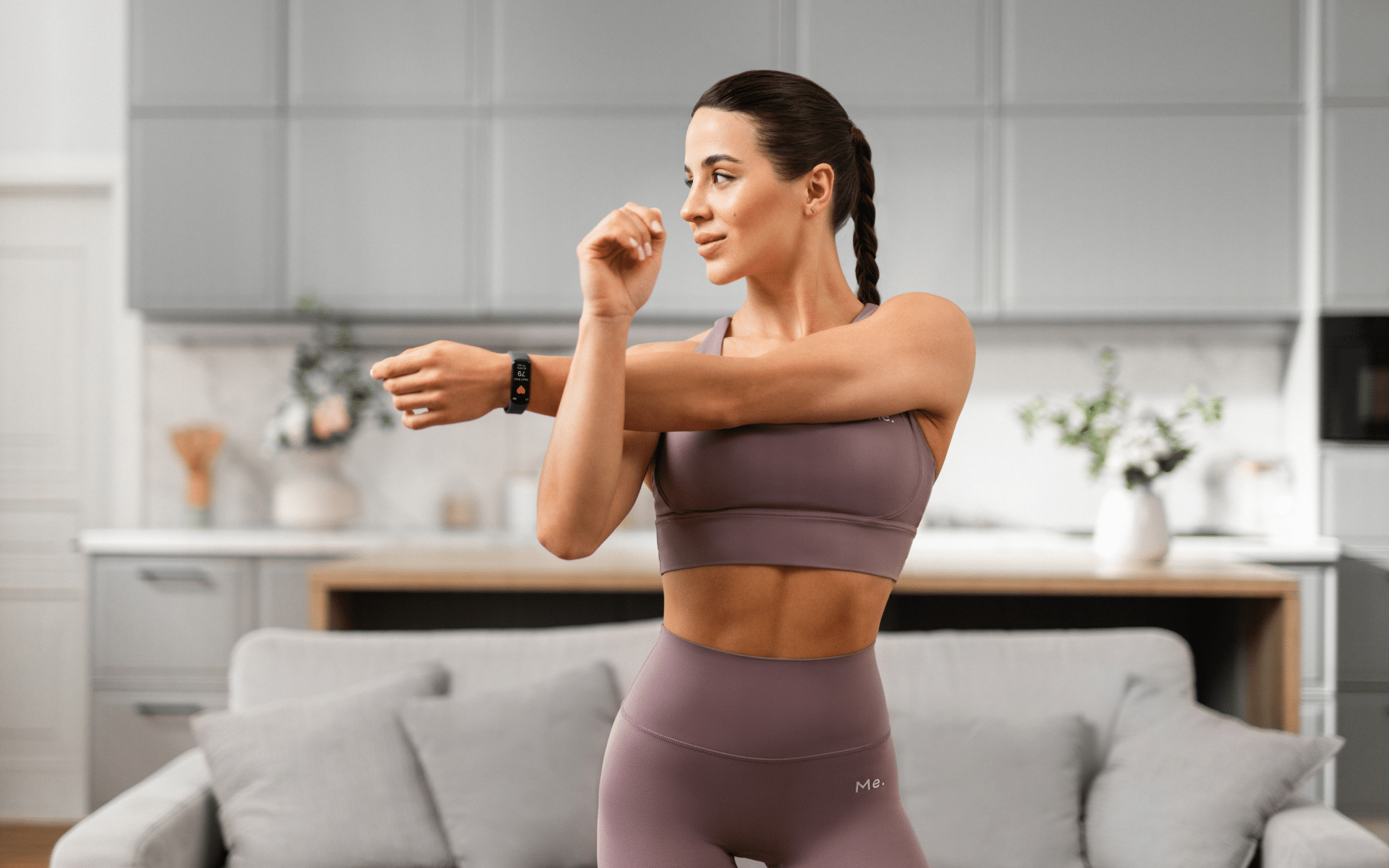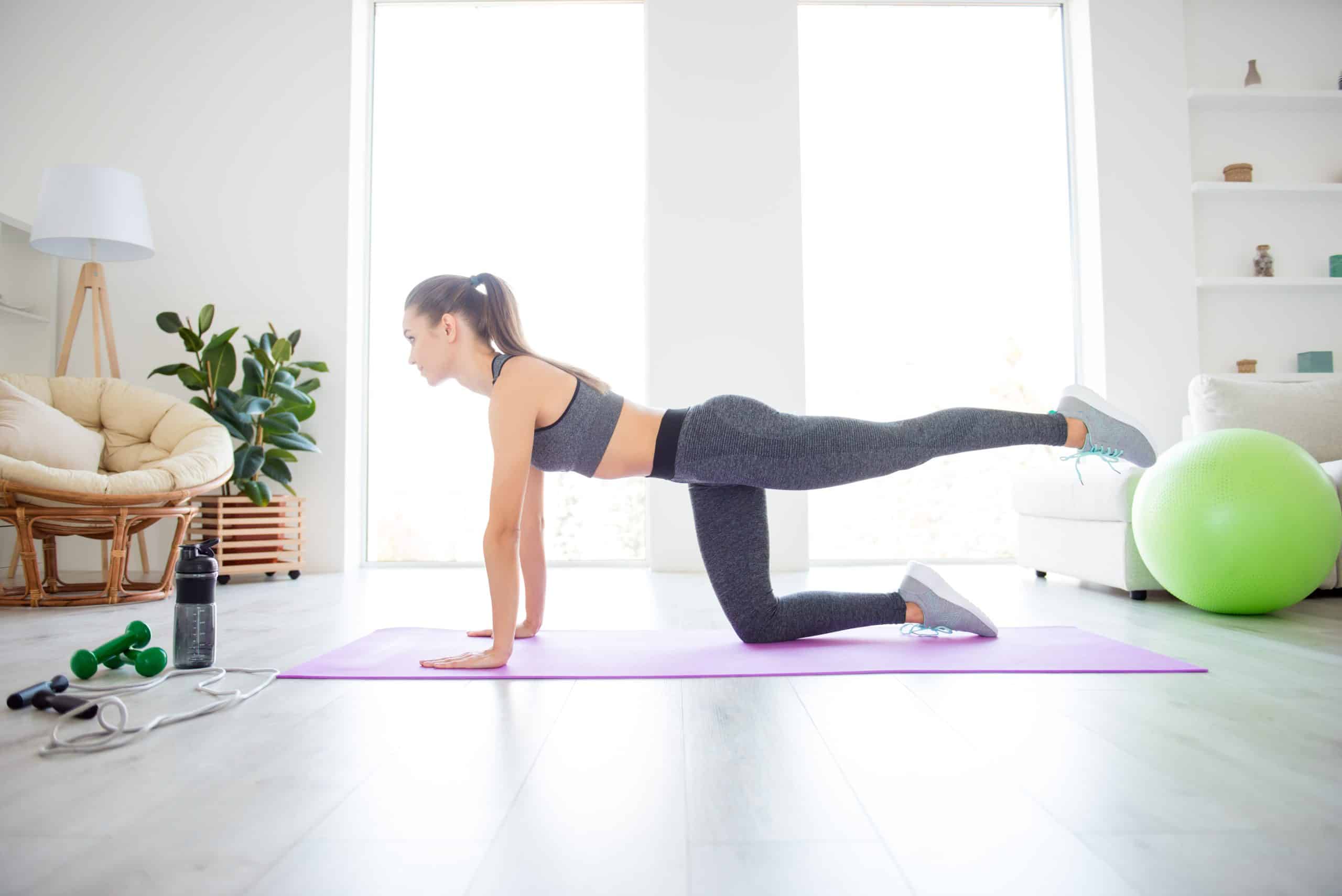What Is HIIT?
High-Intensity Interval Training or HIIT involves bursts of vigorous exercise with short recovery segments. HIIT achieved its buzzworthy status for a number of reasons. One of them being able to squeeze in a highly effective workout even when you’re in a time crunch or have an overwhelming jam-packed schedule. In the 30-minute time frame you’ll be able to break into a sweat, get your heart rate up, push yourself into the anaerobic zone, galvanize your metabolism and stimulate the afterburn effect.
What Are HIIT Workouts?
The cardio and power exercises are continuously performed non-stop. That kind of training is an interval, due to the rotation of the exercises. Continuous exercising makes it highly intense. Beginners can take a short break between circuits. It should be no more than 10-20 seconds.
The usual training is divided into circuits. For example, 60 seconds of running in place, 60 seconds of squats and 40 seconds of the bar. Workouts consist of 6 – 12 circuits. The lesson lasts for 20-30 minutes (1, 4, 7).
The Benefits And Advantages Of HIIT Training
The biggest advantages of high-intensity interval training are working out for shorter bouts while still torching more calories than ever. On top of that you won’t have time to be bored because HIIT usually consists of a variety of exercises which will keep you on your toes. Also, because it lasts no more than 30 minutes, HIIT workouts are suitable for those who do not have much time for physical activity. You’ll get maximum results in minimum time.
During cardio training, only slow muscle fibers are involved, which get the energy from fat cells. But during HIIT training, fast muscle fibers are also used, for which glucose and glycogen are the sources of energy. Due to the fact that the body is constantly switching from fat to glucose and vice versa, metabolism is greatly accelerated, and the muscles become “dry” even faster. Fat cells are also burning at the same time (3, 4).
Read More: HIIT Workouts For Men: Pack A Ton Of Work Into A Short Amount Of Time
With This Training You Can
- quickly lose weight;
- improve stamina;
- burn about 400 calories in just 30 minutes;
- reduce insulin sensitivity (insulin hypersensitivity is one of the main causes of weight gain and type 2 diabetes);
- burn calories long after the workout is over;
- retain muscle mass while losing fat;
- strengthen the heart muscle and improve the functioning of the cardiovascular system;
- develop strength and endurance at the same time;
- rev up metabolism and boost growth hormone;
HIIT doesn’t require any equipment, so you’ll only need some motivation and self-discipline. Gear up and get it done!
HIIT training is shorter in time than cardio training, and more effective at the same time.
Want to build an attention-grabbing bubble butt, blast away fat that’s stored in all the wrong places, spring-clean your diet, turn back the clock on your skin, skyrocket your self-confidence and shatter your insecurities? Check out the BetterMe app and set this plan in motion!
How Much HIIT Per Week To Lose Weight?
The generalized tips of the average training at HIIT, without taking into consideration specialization (more cardio or more power training) are as follows:
Warm-Up (duration 5-10 minutes)
Prepping for such a killer workout, requires a smart approach. It means that in order to properly limber up (rev up your cardiovascular system, activate your muscles, guard yourself against injury, increase your range of motion), you need to piece together a warm-up routine that factors into every part of your body and primes your muscles for an intense workout. Here’s an example of a good start:
1. Skater (repeat 30 sec):
- Push off one leg to jump sideways as if you were ice skating.
- Land on the other leg The momentum from your jump should keep pulling you when you land.
- Use your arms and legs to balance and avoid falling over Repeat on the other side by jumping right back
2. Jumping Jacks (repeat 30 sec):
- Stand. Make sure you have enough space around you.
- Start with your feet together and arms by your sides, then hop up, spreading your legs wide and raising your arms high above your head.
- Alternate between these two positions.
3. Mountain Climbers (repeat 30 sec):
- Start in a high plank position, hands on the floor, wider than shoulder width.
- Drive your left knee in toward your chest, then quickly step it back to plank position.
- Immediately drive the right knee in toward the chest, then quickly step it back into plank position.
- Alternate foot position rapidly, as if running in place
HIIT training consists of two components: a high-intensity load and a low-intensity load. These two components interchange among themselves. You can use the same exercise for both circuits. For example, a bike: first you need to pedal with maximum effort (intense phase), then the same thing, but with moderate intensity, reducing resistance to a minimum (low-intensity phase).
Another option: perform a 16 kg kettlebell jerk in the high-intensity phase, and rest in the low-intensity phase; the body changes into a low-intensity phase, trying to catch its breath and restore strength; then a new circuit.
Hitch And Stretching (duration 10 minutes)
The total duration of HIIT training is usually from 15 to 30 minutes, excluding warm-up and hitch(5). For the beginners at the HIIT, the duration of the high-intensity interval is 10-15 seconds, low-intensity is 3-5 times longer. As physical fitness improves, the duration of the high-intensity interval may increase, and the low-intensity interval may decrease.
Please, note that the frequency of training at HIIT should not exceed 3-4 times a week. More frequent intensive loads negatively affect both the cardiovascular system and the central nervous system (1, 5). The latter can cause overtraining and general depression!
Read More: HIIT Workouts With Weights: This Hardcore Strength-Boosting Routine Is Sure To Leave You Sore
Workout Sessions
Examples of the distribution of workouts over time depending on the main goal of the trainee:
Power And Mass Training
2-3 times a week, 5 cycles: 10-20 seconds high-intensity phase (exercises with heavy “iron”), 2-3 minutes low-intensity (you can use just brisk walking).
Strength And Aerobic Endurance Training
3 times a week, 5-8 cycles: 20-30 seconds high-intensity phase (for example, cardio exercise), 45-60 seconds low-intensity (for example, strength exercise).
Fat Burning Workout
3-4 times a week, 5-8 cycles: 10-30 seconds high-intensity phase, 1-3 minutes low-intensity (a good option – sprinting + jogging).
When it comes to weight loss, progress is made by inches, not miles, so it’s much harder to track and a lot easier to give up. BetterMe app is your personal trainer, nutritionist and support system all in one. Start using our app to stay on track and hold yourself accountable!
Training To Keep Fit
3 times a week, 4-5 cycles: 10-20 seconds high-intensity phase, 30-40 seconds low-intensity (you can use some kind of plyometric exercise, for example, jumping rope at high and low pace; or strength exercise + cardio exercise).
To jazz up your HIIT routine you can always fall back on the good ol’ tried-and-true cardio exercises to ramp up your results: biking, sprints, rowing, jumping jacks, burpees, push-ups, bodyweight squats, etc.
If you really wish to reap all the rewards of the murderous workout you’ve put your body through, you need to give it a moment to pull itself together once you’re done with your sweat session. What we’re hinting at is that skipping a cooldown is out of the question, no matter how crunched for time you are. Before you rush off, make sure to squeeze in these stretches to bring your heart rate back to normal:
1. Overhead Lat Stretch (30 sec. each side):
- Bend your knees so that you are seated on your feet.
- Extend your left arm above your head, then bend at the elbow, reaching your hand between your shoulder blades.
- Grab your left elbow with your right hand and pull it toward the midline of your body.
2. Side Stretch (30 sec. each side):
- From a standing position, reach your right arm over your head and to the left.
- As you reach, bend at the waist while moving your left arm to the right in front of your hips.
- Stay in this position for 30 sec. Then return to the starting position and repeat on the opposite side.
3. Cross Legged Chest to Floor (30 sec.):
- Sit cross-legged with your arms to the side.
- Reach with your arms to the ceiling.
- Bend from your hips and lower down drawing your navel into the lower back. Reach with your arms to the opposite wall, letting your chest float over the legs.
- Hold in this position.
What To Eat Before HIIT?
Try to eat healthy light snacks 45-60 min before the training, which includes protein and carbohydrates to have enough energy before the workout (1).
For example:
- Almond butter
- Granola
- Greek yogurt
- Fruits
- Nuts
- Oatmeal
- Protein shake
- Smoothies
30-40 minutes after the training, you can drink a protein shake or whey protein. It’s generally recommended that in order to reload your muscles, you should eat a full meal consisting of meat or fish with vegetables and fruits approximately within 1-1.5 after your workout. All this should be either fresh, steamed, baked, or grilled, but not fried.
Common Mistakes During The Training
Use of isolating single-joint exercises during training with weights. The energy intensity is insufficient, it is better to change for multi-joint basic movements (3, 7).
The prolonged high-intensity phase of the training and, which may cause the loss of intensity. No need to do a high-intensity phase longer than 30 seconds.
Not enough rest between workouts. Some people try to arrange jogging during non-training days, motivating the fact that the fat burning process will go even faster. This is wrong, the muscles and central nervous system will not have time to recover from the previous training, so you can induce overtraining (2, 8).
Absence of warm-up and hitch.
Loads increase too fast. Increase complexity gradually.
Doing workout late in the evening. HIIT morning exercises are more effective in terms of burning calories (4).
Conclusion
Each of us has different goals and opportunities: for some people, there is no need for HIIT (for example, for people who train endurance without regard to the percentage of fat in the body). However for others this training method is absolutely perfect for burning fat (2, 4).
Moreover, if jogging in the fresh air brings psychological pleasure – do not deny yourself the pleasure of running several kilometers, especially in the open air.
But, if the goal is to slim down by burning fat and get in shape in the shortest possible time, then HIIT is one of the most effective ways to achieve it!
DISCLAIMER:
This article is intended for general informational purposes only and does not address individual circumstances. It is not a substitute for professional advice or help and should not be relied on to make decisions of any kind. A licensed physician should be consulted for diagnosis and treatment of any and all medical conditions. Any action you take upon the information presented in this article is strictly at your own risk and responsibility.
SOURCES:
- American College of Sports Medicine position stand. Quantity and quality of exercise for developing and maintaining cardiorespiratory, musculoskeletal, and neuromotor fitness in apparently healthy adults: guidance for prescribing exercise (2011, ncbi.nlm.nih.gov)
- Comparison of High-Intensity Interval Training and Moderate-to-Vigorous Continuous Training for Cardiometabolic Health and Exercise Enjoyment in Obese Young Women: A Randomized Controlled Trial (2016, ncbi.nlm.nih.gov)
- Dissimilar Physiological and Perceptual Responses Between Sprint Interval Training and High-Intensity Interval Training (2016, ncbi.nlm.nih.gov)
- High intensity interval exercise training in overweight young women (2012, ncbi.nlm.nih.gov)
- High-Intensity Interval Training and Isocaloric Moderate-Intensity Continuous Training Result in Similar Improvements in Body Composition and Fitness in Obese Individuals (2016, ncbi.nlm.nih.gov)
- The acute effect of exercise modality and nutrition manipulations on post-exercise resting energy expenditure and respiratory exchange ratio in women: a randomized trial (2015, ncbi.nlm.nih.gov)
- The effects of short-term high-intensity interval training vs. moderate-intensity continuous training on plasma levels of nesfatin-1 and inflammatory markers (2015, ncbi.nlm.nih.gov)
- Two minutes of sprint-interval exercise elicits 24-hr oxygen consumption similar to that of 30 min of continuous endurance exercise (2012, ncbi.nlm.nih.gov)



